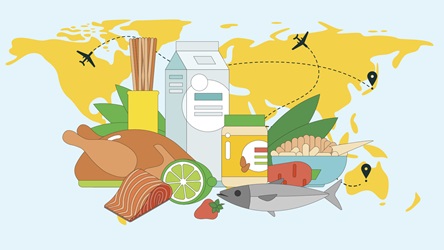Bringing Help Closer To Homes
 When you see litter, what do you really see? For a team of officers from the Kreta Ayer Social Service Office (SSO) walking through the neighbourhood several times a day, cigarette butts and beer bottles at a spot hint at a gathering the night before.
When you see litter, what do you really see? For a team of officers from the Kreta Ayer Social Service Office (SSO) walking through the neighbourhood several times a day, cigarette butts and beer bottles at a spot hint at a gathering the night before.
The walks are a way for the officers to learn more about the local residents – and how they could better help them. Armed with a map with community assets like rental blocks and gathering spaces marked out and taking notes and photos, the officers later compile their observations to get a better picture of what goes on in the community.
Located at Sago Lane, the Kreta Ayer SSO is a social service middleman for residents in Bukit Merah and Outram. SSOs are the government’s latest effort to integrate social services and bring help points closer to residents in need.
Proximity counts
Open since July 2013, the Kreta Ayer SSO has four local planners and nine social assistance officers. Some were probation and policy officers before, while others were staff at Community Development Councils (CDCs).
Together, they now work with over 100 community partners to identify unmet social needs. SSOs also provide financial aid under the ComCare scheme, previously only available at the five CDCs.
By mid-2015, there will be 20 SSOs, one in every major Housing and Development Board (HDB) town. Along with 45 Family Services Centres (FSCs), they will form the core of a network of help services. This means 95% of needy residents will be able to access SSO services within 2 kilometres of where they live or work.
A shorter travelling distance means that if applicants forget to bring along documents, they can easily pick them up from their homes or return the next day.
Ms Dorcas Koh is a social assistance officer at Kreta Ayer SSO who previously worked at Central CDC in Toa Payoh. There, she was responsible for clients in many neighbourhoods over a large area. When elderly residents called to get help in reading official letters, for example, she could not always visit them and had to tell them to go to the CDC instead. The Kreta Ayer SSO’s proximity to the people they serve means Ms Koh can now conduct home visits more often.
The SSO’s site within the community also means officers can “bump into” residents and chat with them. “They feel more comfortable because they see us around and they know that if they have difficulties, they can come to us,” says Ms Koh.

Goodwill with partner agencies
When the SSO plans first official meetings with partner agencies, like the HDB, they go to the other agency’s office to meet on their turf. “Going down to meet them is to show our presence, [but also] acknowledging that they have been there for a much longer time,” says Ms Jessica Fong, a member of the SSO’s local planning team.
For stronger ties with their partner agencies, SSOs have a designated point of contact for them, dubbed the “Relationship Manager”.
“One way of building trust in a relationship is really when you put a face to the person at the agency you are dealing with,” says Ms Fong, who is Kreta Ayer SSO’s relationship manager for the local HDB branch and the police. “It’s a lot easier … not having to go through a hotline.”
The goodwill built up over time makes it easier for the local planning team to gather data and share information with their partner agencies. Data from the agencies may not be detailed statistics, such as the exact number of drug users, but confirmation of any issues in the community through anecdotal information from partner agencies is enough for the team to get started. The planners then work with their social assistance colleagues and other partners to come up with a course of action.

Sharing is caring
“We consult the people [community partners] we are working with, and not just say, ‘Here are the statistics, go do something about it’,” says Ms Fong. “It’s a lot more collaborative.”
The SSO also sometimes shares the client reports by the social assistance officers with FSCs in the community. This reduces the hassle for those in need of social assistance, who otherwise have to send repeat requests to different agencies.
Mr Jai Prakash, General Manager of the Kreta Ayer SSO, says: “Sometimes the client will be frustrated: ‘I just came this morning to see the FSC, now I need to come [to another agency] again.’ We try to minimise these things.”
The other purpose of sharing information is to help agencies understand a client’s perspective. “We want all the helping agencies to have an understanding, before we meet the client and then decide what to do exactly,” says Mr Prakash.

Let’s take a walk
Such collaborative efforts also extend to community events. The SSO recently joined police officers on a crime prevention awareness community walk, “kill[ing] two birds with one stone”, says Mr Prakash.
During the walk, the SSO officers helped the police respond immediately to residents’ queries on social assistance, while the police identified needy residents not known to the SSO.
The police also introduced the SSO to their own community partners, such as Outram Secondary School. “When the ‘marriage’ came through the police, the schools had [greater] trust in SSOs,” says Mr Prakash.
In fact, the SSO officers were later even invited to Outram Secondary School’s cross-country run – timely for them, as they wanted to understand more about the youth in the area. Even if it meant putting aside time from their normal duties to spend hours in the hot sun, striking up conversations with sweaty, energetic youths, that’s an effort the SSO is willing to take to keep growing good relationships within the community.
This article is part of a series 7 Ways To Go Steady With The Public.
- Growing With Our Citizenry
The social contract between Singaporeans and the government is changing. How should government agencies respond? - Earn Trust By Connecting Emotionally
Head of Civil Service Peter Ong on the elements of trust and where the Public Service can do better. - How Openness Strengthens Relationships
Sharing data and crowdsourcing through hackathons is bringing two public agencies closer to the public. - Co-Creating Singapore: Citizens Have Their Say
As Singapore moves towards a new relationship between people and government, three active citizens say it's time to give the people a bigger role in co-creating Singapore. - Let's Get Personal
There is no foolproof way to make any Facebook, Instagram or Twitter post go viral. But some public agencies have begun to show that humour and "keeping it real" can help them engage the public like never before. - They've Got Your Back
Challenge talks to four winners of this year’s PS21 Star Service Award who have earned the public’s trust by being there for them.
- POSTED ON
May 14, 2014
- TEXT BY
Cerelia Lim
- ILLUSTRATION BY
Ryan Ong
-
Deep Dive
Strengthening Singapore’s Food Security
-
Deep Dive
Making Collaborative Consumption Work
-
Profile
Looking Out For All








.tmb-tmb450x250.jpg)
